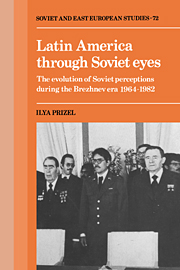 Latin America through Soviet Eyes
Latin America through Soviet Eyes Book contents
- Frontmatter
- Contents
- Preface
- Acknowledgments
- Introduction
- Part I Soviet perceptions of Latin America's global role
- Part II Soviet perceptions of Latin American social structures
- Introduction
- 6 The Latin American church
- 7 The Latin American armed forces
- 8 Latin American labor unions
- 9 Bourgeois political parties
- 10 Wars of national liberation or peaceful transformation?
- Part III Soviet–Latin American relations during the Brezhnev era
- Part IV Conclusion: the emerging Soviet perception of Latin America and the future of Soviet policy toward the hemisphere
- Conclusions
- Epilogue – Latin America: the Long March
- Notes
- Bibliography
- Index
9 - Bourgeois political parties
Published online by Cambridge University Press: 05 February 2012
- Frontmatter
- Contents
- Preface
- Acknowledgments
- Introduction
- Part I Soviet perceptions of Latin America's global role
- Part II Soviet perceptions of Latin American social structures
- Introduction
- 6 The Latin American church
- 7 The Latin American armed forces
- 8 Latin American labor unions
- 9 Bourgeois political parties
- 10 Wars of national liberation or peaceful transformation?
- Part III Soviet–Latin American relations during the Brezhnev era
- Part IV Conclusion: the emerging Soviet perception of Latin America and the future of Soviet policy toward the hemisphere
- Conclusions
- Epilogue – Latin America: the Long March
- Notes
- Bibliography
- Index
Summary
Throughout the Brezhnev era the Soviet attitude toward the “reformist” parties in Latin America evolved in connection with the changing realities of the region. (This chapter centers around parties perceived by the Soviets as reformist, since the Soviet posture toward the political right wing was consistently negative.) Although some of the region's many states followed different paths of development, three phases emerge as key in the history of Soviet reassessment of Latin American bourgeois parties.
Initially the debate focused on whether these parties wanted only to “update” the status quo or whether they could be considered allies in a political and social transformation. As military rule swept the region they were evaluated as a potential partner against the fascist threat. With the fall of many military regimes and the victory of the Nicaraguan guerrillas, their importance to the communist cause would diminish.
Soviet perceptions and policy toward Latin American bourgeois parties 1964–70
The Soviet attitude toward bourgeois political parties of Latin America was hostile during the early Brezhnev years for several reasons. First, the historical relationship between the Latin American “reformist” political parties and the communist parties was tense and highly competitive. Although the communists had cooperated with several progressive parties – such as the Videla regime in Chile, the Vargas regime in Brazil in its early phases, the Perón regime in Argentina, the revolutionary coalition that preceded the PRI party in Mexico, and the Batista regime in Cuba – such cooperation had ultimately resulted in a break between the two groups, with the communists invariably weakened.
- Type
- Chapter
- Information
- Latin America through Soviet EyesThe Evolution of Soviet Perceptions during the Brezhnev Era 1964–1982, pp. 119 - 134Publisher: Cambridge University PressPrint publication year: 1990
